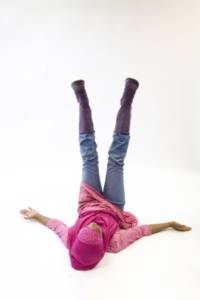Kathy Flaminio is a social worker, certified yoga instructor, researcher, and witness to the power of mindful movement to transform a child’s academic success and emotional well-being. She’s also the founder of 1,000 Petals, a Minnesota-based consulting company that offers education and training in the science and practice of mindfulness and movement.
Research shows that in addition to reducing a child’s anxiety and boosting self-esteem, yoga also improves classroom behavior and academic performance. That’s because the benefits of yoga—soothed nervous systems, lowered heart rates, and thoughts that are tethered to the present—put the brain in its optimal learning state.
By learning to regulate their heart rate through movement and breath work, kids also learn that they can choose to feel differently in their bodies, even when they’re distressed. This agency cascades through the rest of their lives: How they feel and react in social situations, in the classroom, and at home.
We spoke with Kathy to discover simple techniques that teach kids to regulate and reduce their own stress responses. You can practice these exercises in as little as one-to-three minutes.
A Regular Practice Is Ideal
Kathy teaches the 5-S Technique, which you can incorporate into your routines throughout the day, regardless of your family’s current stress level. Once these techniques become habit, your child (and you) will be able to turn to them when he/she is experiencing a difficult emotion.
1. STOP
Ground your body by placing your feet on the floor or sit deliberately in you chair and lengthen your spine. Slow your breathing. When you take deep breaths you activate the relaxation response.
2. SIGH
Sighing is the body’s natural way of releasing stress. Take a nice deep breath in and exhale a vocal “ahhh.” Do this at least five times, and take note of any changes in the mind and body.
3. STRETCH
Every day, move your spine in six directions: front/back (arms up over head and forward fold the body), side to side (lift arms over head and move the torso laterally), and twisting (seated or supine twist)
4. SHAKE
Shaking is another way of dissipating stress in the body. Start standing, and gently start to shake your arms, your legs, your hands etc. Try to shake for two to five minutes—you can put on some music to give you extra energy. Then gently sway side-to-side, stop, close your eyes, and feel.
5. SMILE
Smile at five people each day (especially the ones you’d rather not smile at!). Smiling triggers the left frontal cortex, the area of the brain where we register happiness. If you want to release more stress, add laughter. Laughter lowers blood pressure, increases your attentiveness and energy levels. Even if you aren’t in a great mood, faking your smile and your laughter will give you the same benefits.

But You Can Make Any Moment Count
• If your child is having trouble calming down, or you’re mid-conflict, try disengaging from words and turn to the body. Holding Legs-Up-The-Wall pose for five-to-ten breaths is a quick and fun way to help you and your child keep calm.
• In the classroom, kids can incorporate seated poses to lower anxiety and regain focus. Seated spinal twists, backbends, and forward folds (with the forehead coming to rest on the hands or the desk), coupled with slow, deliberate breathing can be very calming.
• Mindfully tensing and releasing muscles is a discreet way for kids to soothe their bodies and minds during an exam. A relaxed jaw and softness around the eyes is important here.
• If you want to get your family in sync, try eating together mindfully. Before taking a bite, ask your kids to examine their food with care, noticing the colors and aromas. Have everyone take a bite and chew slowly in silence for a minute, paying attention to the flavors and textures. At the end of the exercise, ask everyone to share what they noticed about their food.
Because making yoga-based movement part of the long family must-do list, (or feeling guilty about not-doing) can undermine their benefits, it’s important to figure out what methods feel easiest to incorporate into your existing routines. The key to all of these practices, according to Kathy, is to involve your body with your emotions in a strategic way. Notice how your body and mind feel (ex. Are you energized or lethargic? Anxious or focused?) and select movements that will balance your thoughts, emotions, and physical sensations.
Want to learn more about mindful movement and stress reduction? Check out Kathy’s all-day Wellness Workshop on Saturday, November 18.







